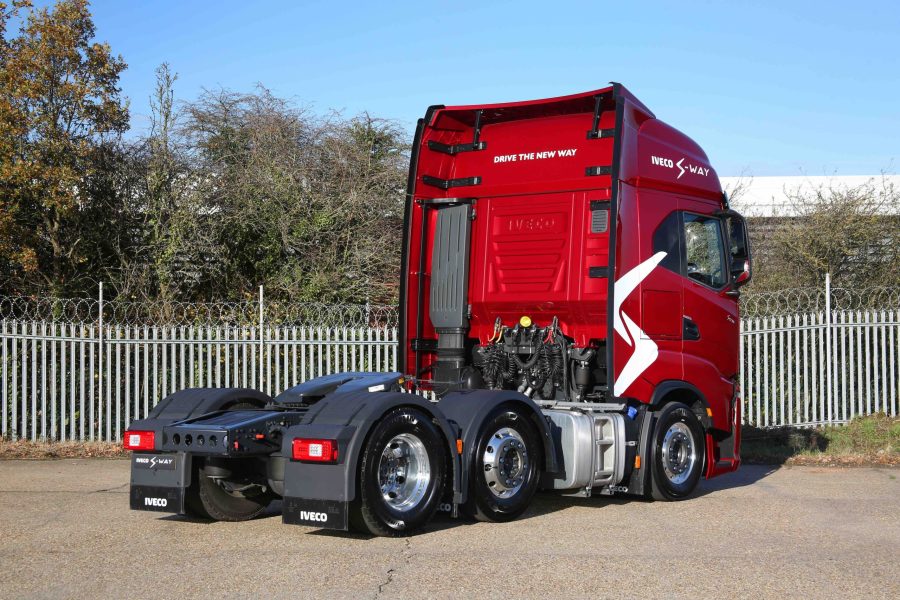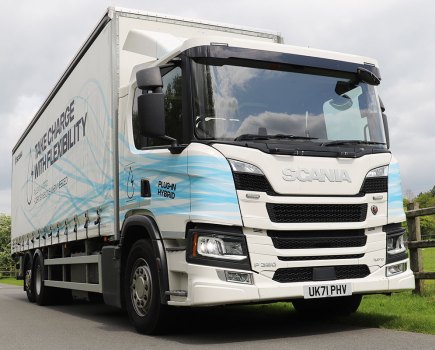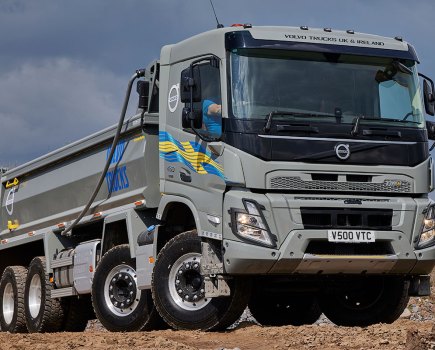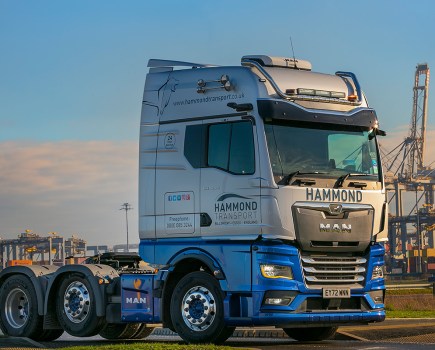Pandemics don’t help truck launches, and for Iveco it has suffered with delays to getting its new S-WAY to the UK. But it’s here now, and Trucking took it for an extended two-day road test, complete with a sleepover
It was July 2019 when we first drove the new Iveco S-WAY, but a couple of laps around a racetrack in a left-hand drive model with no load and no traffic only gave the slightest of tasters of the new truck. What we really wanted was an extended road test under proper road conditions.
It wasn’t possible to arrange such a test in Italy or Spain, but just as it looked like a UK test with a 6×2 right-hand drive S-WAY was on the cards, COVID came and scuppered it. Finally, and under current protocols, we were able to take an S570 out for a thorough road test.
What was great about this test was it was pretty much without restriction. There was no Iveco rep with us; we simply picked it up with the promise of returning it the following day.
Technical overview
The test truck was an AS440S57TX/P, which is a technical description for a 6×2 twin-steer tractor unit in top-of-the-range spec with the 570 bhp (at 1900 rpm), 12.9-litre Euro 6d Cursor 13 engine. This engine delivers 2500 Nm of torque at 1000-1605 rpm. As is the norm with Ivecos, it uses SCR to meet its emissions ratings.
The truck was fitted with the Hi-Tronix 12TX 2620-TD 12-speed automatic gearbox with ratios from 16.69 to 1. The rear axle ratio was 1:26.4 and the truck was shod with alloy wheels throughout and fitted with 315/70R22.5 tyres.
It had the Active Space high-roof twin-bunk sleeper cab in an attractive metallic red, disc brakes all round, plus front parabolic suspension and rear air suspension on its 4000 mm wheelbase.
A 290-litre fuel tank and 50-litre AdBlue tank was fitted. Overall, the truck tipped the scale at an impressive 8130 kg, which is superb for a top-weight, high-powered 6×2 tractor. With the smaller Cursor 11 engine, you’ll get that under eight tonnes. Go further – eg, small mid-lift and perhaps a smaller cab option – and you could be looking at a 7500 kg tractor for 44-tonne operations.
Day one
With 570 horses and a gross weight a fraction under 40 tonnes, we expected the Iveco to perform well. After a socially distanced handover, we wheeled the big red S-WAY out of the Dunstable base and headed first for a bit of motorway driving. Our plan was to take the M1 southbound, then M4 westbound and head into South Wales; so long as we got a mix of roads under our belt, we’d be happy.
Getting into the S-WAY is via three steps. The cab doesn’t have a truly flat floor, but with an engine ‘hump’ of just a couple of inches, it’s not far off. We actually prefer this set-up; having a truly flat floor requires four steps and entry and exit start to become a chore – putting a week’s worth of overnight gear into the cab can be a bit of a pain. This is a happy comprise; easier access and just as much room.
The dashboard on the S-WAY is very similar to the Stralis models this truck has replaced. One the one hand, it isn’t as modern as, say, the new Mercs, Volvos or MANs; but it’s not bad.
It’s a reminder the gestation period for the S-WAY has been (S-) way too long; the first images of complete S-WAYs were seen over three years ago, some 18 months before the official launch in July 2019. It’s fair to say – especially in terms of the dash – it’s simply been overtaken by the competition.
We have a few minor gripes with the layout; not least that the headlight switch is tucked down out of sight to the left of the steering column. A regular driver will soon learn where it is and it won’t be an issue, but for a driver told simply to hop into one, it might take a while to find it. It’s poorly positioned and needs to be more prominent.
One good thing about lockdowns is reduced traffic, and even though Lockdown 3 is nothing compared with the first one in terms of empty roads, the M1 was flowing well – and indeed the M25 was a breeze. Onto the M4 and we soon hit miles and miles of roadworks.
The cruise control on the S-WAY is easy to use and works very well. The buttons to use it are on the steering wheel (in this case, on the right-hand side), so we set it to 50 mph, sat back and enjoyed the ride.
Once back on the clear motorway, it was back up to 56 mph. Not much was passing us, even on the slight inclines, and it took a stiff climb for the truck to even consider dropping down to 11th. One thing we have noticed with many modern trucks is their ability to run away on the downhill slopes if you are not careful, even when running on Cruise Control. The S-WAY didn’t do that; at most it went up to 59 mph, and on the odd occasions it looked like it might get a little bit more excitable, using the six-stage engine brake corrected it, even on stage 1.
Some truck engine brakes are a bit weak, but the Iveco’s is very good indeed. We liked the vast range of stages – so much more useable than a two- or three-stage EB some trucks have. Overall, controlling S-WAY is very easy.
As the sun set passing near Cardiff, its bright rays were directly in our eyes. TheS-WAY, like other makes, has pull-down blinds, although there is a sizeable gap on the right-hand side which is a bit irritating (although this is not unique to this model; it affects other as well).
Into the countryside
After stopping for a bite to eat at the end of the M4 just west of Swansea, we took the A483 north through Ammanford and then onto Llandeilo. This gave us a chance to see how the truck handled on a twisting, turning and undulating road, with plenty of cause to reduce speed to legally pass through the villages at 30 or 40 mph followed by acceleration to get going again.
Here we found the S-WAY offered a particularly enjoyable drive. It held the road superbly, and only it only huffed and puffed a bit on the really stiffest climbs that started at low or no speed – as would any truck at this weight.
Iveco’s build quality has been criticised over the years, but there was not a single rattle or squeak to be heard on this machine. It was wonderfully quiet and the build quality felt superb. The seat was also very comfy – it’s easy to adjust, has a heater and good armrests.
Overnight
We found a suitable lay-by away from the road and pulled in to park up for the night. Now was the chance to see how comfy the truck was to bed down. S-WAY is fitted with a Night-lock to give extra security and make it harder – or nigh-on impossible –to break in. You need to use it on both doors, however! The truck also has a lockable fuel cap to reduce the risk of diesel theft.
The truck had an under-bunk fridge, but no microwave or coffee-maker (but then, not too many press trucks have such features). The fridge definitely did its job well, though.
The cab layout is ok. While some may feel it’s not especially spectacular, it’s roomy enough and fit for purpose – but it doesn’t have a real ‘wow’ factor. But for tramping, once you’ve stamped your mark on it, the cab does become a home from home. It could do with a pull-out table on the passenger side, however.
The bunk is very comfy, both for a light rest or a full night’s sleep. One thing we noticed was how good the curtains are. They’re thick, block out all light and covered all the windows exceptionally well. They also didn’t start to drift apart. There are double USB plugs sockets at both ends of the bunk – a real improvement on the Stralis.
By the bunk are a few buttons for lighting, heating and the sunroof – the latter we accidentally opened, and in doing so noticed it was rather a noisy as it opened and closed.
Inside the cab is very quiet and a good night’s sleep is assured for those who don’t struggle to sleep in trucks as a rule. There’s no noise, no light. However, we were of course sleeping in a layby on a quiet Welsh road during a lockdown, so passing traffic was limited. Parking in a truck stop with lots of other trucks coming and going, fridge trailers running and lots of lights might be a little bit more challenging.
Day two
Our route back to Dunstable was cross-country through Wales to join the M50 for a mix of motorway and dual-carriageway driving, heading north on the M5, then the M42, M40, A46, A45, M45 and M1.
We started eastbound on the A40 to Llandovery and then on through the superb scenery at the top of the Black Mountains and the lovely Brecon Beacons, getting to Brecon itself. This is all single-carriageway round with limited scope to use the cruise control, and it has lots of twist and turns, hills and descents and tight villages and towns.
Once you have positioned them to suit you, the mirrors on the S-WAY are very good. At the launch in July 2019, it was asked of Iveco engineers why conventional mirrors were still a feature and why Iveco had not followed Merc’s mirrorless camera technology. Iveco replied this tech was “on its way”; but some 18 months on there’s still no sign of it. A delay due to the pandemic, perhaps? That said, conventional mirrors are still fine and fit for purpose, and those on the S-WAY are fine.
Thankfully you can avoid actually going into Brecon itself and we carried on the A40 to Abergavenny, where there was a bit of town driving and some tight turns, all comfortably accomplished. Monmouth, on the other hand, was totally avoided thanks to the bypass and then it was on to the M50.
Once back on the motorway, we could revert to driving almost exclusively using the cruise control and engine brake. The visibility from the windscreen is superb; no issues to report there. The rest of the drive back to Dunstable was pretty uneventful, bar a short detour through Kenilworth.
Product range
Given its newness, you may not be overly familiar with the S-WAY range, so here’s a recap. There are two cabs: narrow (due to be launched in the UK imminently) and the full-width cab test here. The former (the AT and AD) is available in day, sleeper and high-roof sleeper; the latter (AS) in just the two latter formats.
Outputs wise, there the 8.7-litre Cursor 9 engine at 330, 360 and 400 bhp and 1400, 1650 and 1700 Nm respectively. The popular 11.1-litre Cursor 11 is available in 420, 460, 480 bhp and 2000, 2150, 2300 Nm variants, while the 12.9-litre Cursor 13 (as fitted to this test truck) is available at 510 and 570 bhp with 2300 and 2500 Nm respectively.
Iveco also offers natural gas engines, with Cursor 9NP and Cursor 13NP options available; the former at 340 or 400 bhp, and the latter at 460 bhp with torque ratings of 1500, 1700 and 2000 Nm respectively. The bigger engine is now available as 6×2 which should further increase its appeal.
Iveco probably doesn’t shout about it too much, but manual gearboxes are still an option on the Cursor 9 and 11 4×2 tractors and all rigids – but only on diesels, not on the gas models.
Tractors are available in 4×2, 6×2 twin-steer and now a 6×2 with rear twin-wheel tag axle. 6x4s should follow as well. On the rigids, 4×2, 6×2 rear-steer tag and 6×2 rear-steer pusher are all in the catalogue. The multi-axle X-WAY rigids will be launched soon.
Verdict
It’s time to bin any preconceptions about Ivecos being cheap and nasty. The Stralis was actually a pretty good truck, whatever Scania drivers will tell you, and the S-WAY is much better than its predecessor.
There is nothing fundamentally wrong with this truck whatsoever. It comfortable to drive, it’s well built and – for a driver – its ticks most boxes.
The problem Iveco faces is not in its own product; it’s in the others. Since the S-WAY has been launched and brought to market, new products from MAN and Volvo have come on the scene. If you include the time between the first S-WAYs being tested and then launches, you can add new Mercs into that mix. A new DAF is also on the horizon. And that is the problem – the S-WAY’s dash looks a little dated already. But it’s not a bad dash at all.
The driveline on Ivecos is widely held in high regard and was updated before the launch of the S-WAY. Another thing that has always been a good plus point for Ivecos is their low unladen weight; and compared with some other trucks in this power bracket we reckon you could be looking as much as an extra tonne in payload. That is not to be ignored, especially if you are paid by weight. The S-WAY is also a very good-looking truck and makes for a good canvas for liveries or customising.
One of Iveco’s biggest issues is its dealer back-up, which is not as strong as others – and that could be a deciding factor during purchase. If you have a good Iveco dealer nearby then this truck is worth looking at. If you don’t, then the chances are you may overlook it.
While any sensible fleet manager would be wise to cast their eye over an S-WAY, the reality is it isn’t likely to take many sales away from the Swedes. It will pose more of a threat to MAN, Renault and DAF sales, we reckon.
However, the bottom line is S-WAY is both an improvement over its predecessor and can match every other marque in most other areas. It will also beat them in many, and if price is an issue, then the Iveco will be cheaper to buy initially – although that will later transfer to the residuals, which are traditionally lower on this brand.
In short, there’s a sound business case for taking an S-WAY. It looks the business and performs well, and we think any driver who’s told their new truck is an S-WAY should be happy.
SPECIFICATION
Model: Iveco S-WAY S570
• Design GVW/GCW: 44,000 kg
• Chassis: 4400 mm wheelbase
• Front axle: 7500 kg capacity
• Rear axle: 11,500 kg (drive), 700 kg (mid-lift). 1:2.64 ratio. 315/70R.22.5 tyres
• Gearbox: 12-speed TraXon automated transmission
• Engine: Euro 6d Cursor 13 570CV 12.9-litre straight six
• Max power: 570 bhp @ 1900 rpm
• Max torque: 2500 Nm @ 1000 rpm
• Cab: AS high-roof twin-bunk sleeper






